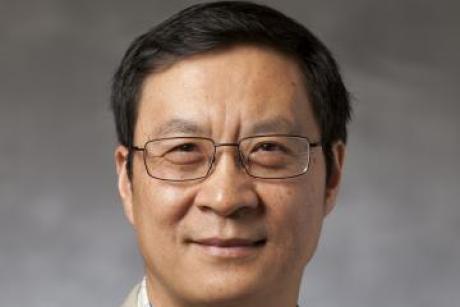
Students in Mark Janko's "Climate Change and Global Health" course measure the circumference of a tree's trunk to determine how much carbon it can store.
Published February 20, 2025 under Education News
On a chilly morning in January, around 20 students bundled up in thick jackets and scarves and left their classroom in the Reuben-Cooke Building on Duke’s campus. Outside, they gathered around a grove of trees and began measuring the trees’ trunks with a thin rope.
After recording the circumference of their trees, the students consulted a ruler that estimates how much carbon each tree can store. One student reported a young tree with a thin trunk offset the amount of carbon used in a 10-minute shower. Another student’s tree, with a trunk so wide it took several students to reach around it, captured carbon equivalent to what would be burned on a 10-day cruise.
“Hopefully, you found this useful, and it connects your day-to-day activities to your carbon footprint,” Mark Janko, Ph.D., an assistant professor of global health, explained to the class.
The short field trip was part of Janko’s course, “Climate Change and Global Health," which is being offered for the first time this semester. The undergraduate-level course introduces students to the drivers of climate change and how shifting weather patterns are impacting human health.
Janko was inspired to design the course after Duke launched its Climate Commitment, which has spurred new research and teaching focused on issues related to climate change and extreme weather. The course has attracted students from a broad range of majors, including Spanish, psychology, economics, biology and global health. It’s the first Duke course to focus specifically on the health impacts of climate change, which is a key focus of the Duke Global Health Institute’s strategy on climate.
“There hasn’t been a course like this at the undergraduate level,” Janko says. “It’s for students curious about this issue, who want to understand more about climate change, why it’s happening and how.”

Mark Janko leads a discussion about...
A geographer and biostatistician by training, Janko’s interest in climate and health comes from more than a decade of research on environmental change in the Amazon rainforest, Madagascar and the Congo basin. In the Amazon, he has studied the impact of deforestation on climate, plants and animal life, including how clearing forested lands creates new routes for mosquitoes that spread malaria and other diseases. He says the changes in the Amazon are bringing the rainforest to a tipping point, where the damage to the ecosystem can’t be reversed.
Janko says climate change will be the largest problem humanity deals with in the future, which is why it’s critical for students to have a broad, interdisciplinary understanding of the issue and its impacts.
“Being able to think through how humans influence Earth-system processes and the pathways through which changes in the Earth system influence health requires being conversant or familiar with a multitude of disciplines,” says Janko, who’s also a founding principal investigator of the Amazon Research Consortium for Climate Change and One Health at Duke.
Early in the semester, students learn about climate changes and how they affect the global environment. The final part of the course asks students to come up with solutions to address the consequences of climate change, drawing on policy and community perspectives.
“They’ll have an earlier chance to get interested in the fundamentals of humankind and what is needed to keep humanity within a ‘safe operating space,’” Janko says. “I want them to leave Duke and be able to communicate about these complex issues as informed citizens, either when they vote or in their future careers."

